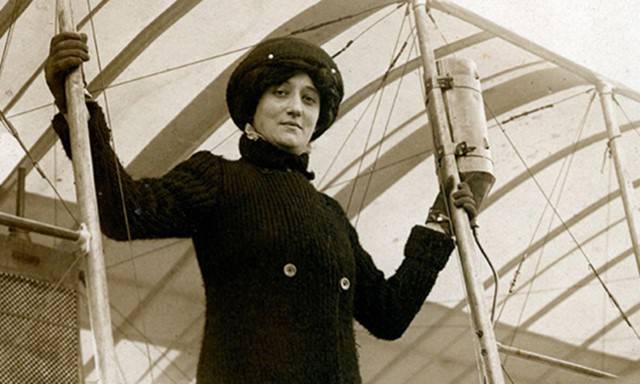Born in 1882 in a small town on the banks of the Seine, the river that carries time and history, Élise Raymonde Deroche lives on today, her name reflected like water in a mirror. Her transition from acting to aviation has proven her lasting legacy.
Between 1908 and 1919, she blazed a trail in aviation, becoming the first woman in the world to earn a pilot’s license on March 8, 1910. Inspired by Wilbur Wright’s demonstration flights in Paris in 1908, a pivotal moment in aviation history, she turned her attention to flying.
In 1909, she began flight training with Charles Voisin, a prominent French aircraft manufacturer of the time. She carried out her first solo flight in a Voisin aircraft, considered to be the first heavier-than-air flight ever performed by a woman. Voisin aircraft were single-seat planes; students sat alone in the cockpit while the instructor gave commands from the ground. While Voisin controlled the plane from the ground, Laroche flew 270 meters on her maiden flight. This flight, not her acting career, catapulted her to fame.
It’s unclear whether her rapid rise in popularity came from her flight achievements or from the “Baronne” title that mistakenly appeared in Flight magazine. Though not actually nobility, Laroche adopted the title “Baroness” to promote herself in both her acting and aviation careers. From then on, she became widely known as Baronne de Laroche.

Despite her passion for aviation, hard work, and courage, she faced numerous challenges, including flight accidents. Even when her health was compromised, she demonstrated her flying skills before examiners. After completing the required maneuvers, she was awarded license number 36 by the Fédération Aéronautique Internationale (FAI) on March 8, 1910, officially becoming the first licensed female pilot in the world.
In 1910, at the Rheims Air Meet in France, she experienced turbulence and crashed. After nearly dying and spending almost two years recovering, she returned to flying. In 1913, she won the Femina Cup, an aviation competition organized by the French Aeroclub exclusively for women to encourage female pilots. She covered 323 km in four hours, setting a new distance record for women.
On June 7, 1919, she reached 3,962 meters in a Caudron G.3, and on June 12, she reached 4,800 meters, setting altitude records. The following month, in July 1919, she tragically died in a plane crash while acting as co-pilot during a test flight of a new aircraft. Her death, however, did not dim her light as an inspiration to women.
Laroche was the first French woman to fly an aircraft solo, and she remains a symbol of pioneering spirit. Her statue stands at Le Bourget Airport in Paris, welcoming arriving passengers.
Today, as the Seine continues to flow like a mirror of the past, March 8, 1910, is commemorated as the day a woman took control of an aircraft and received official recognition for it. With that document, she became the first recognized female pilot in the world, proving that aviation is not a profession reserved for men. This date, which marks a turning point in both aviation history and women’s social status, is also celebrated as International Women’s Day.
To promote women in aviation, the international campaign Women of Aviation Worldwide Week (WOAW) has declared the week of March 8 as World Women of Aviation Week.



